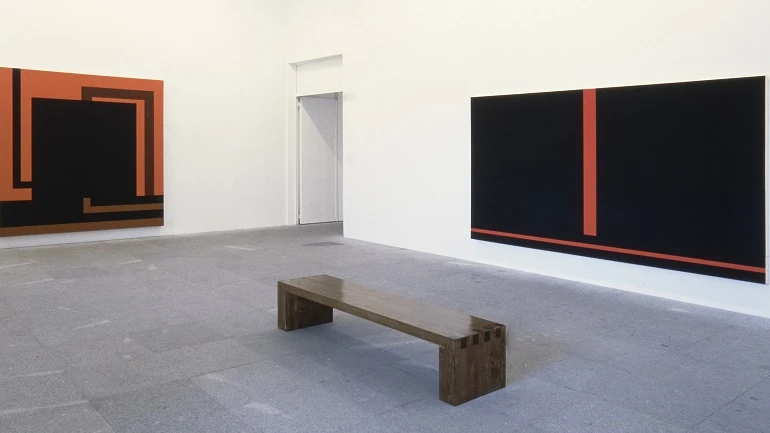Peter Halley

Peter Halley recognises the influence of European and American painting, especially the work of Josef Albers; from him he takes the figure of the square both as a modern icon and as an example of classic geometry. However, Halley's crucial gesture is to turn this geometric abstract figure in the image of a prison, by painting bars on the inside, like in Prison (1985). In this way, he introduces onto the canvas the idea of interior and exterior space, by putting the meaning of prison on the figure, besides creating an object (a significant) inside the painting.
In establishing the binomial of geometry-gaol equality in his paintings, Halley expresses a double critique, formal and conceptual, against abstract, geometric art and, in particular, the Minimal (Sol Lewitt, Donald Judd and Frank Stella). The basis of this and the following steps are the inclusion of conductors that connect two cells, which can be seen in Two Cells with Circulating Conduits (1985), or one cell with the outside, as in the case of Cell with Smokestack and Underground Conduit (1985); this is found in the theoretical contribution of Michel Foucault, from his concept of prison and his criticism of the regulation of life by different institutions. Halley's purpose is to represent the post-industrial landscape and highlight the fact that geometry exists in the real world. Not surprisingly, one of its hallmarks is the use of Day-Glo acrylic, an industrial material that is given to him by culture (as done by the Pop and Fluxus artists), which allows him to recreate a kind of artificial light.
In the period that elapsed between 1987 and 1989 which he considers a transition and during which he participates actively with New York's East Village galleries, his painting is conceptually enriched through the combination of Day-Glo with traditional paints. From a compositional point of view, the relationship between cells and conductors becomes more complex. Through them, his growing interest in the movement is shown and he emphasises the notion of circulation: El sector occidental (1990); Borde de río (1990); Superdream (1991); Overthruster (1991). Expanding on the idea of pretence and the theatricality of movie scenes, especially science fiction, from the beginning of the Nineties he creates sculptures and reliefs in fibreglass as exemplified by way of supplementary exercises to painting: Prisión de hormigón de escoria (1990) and Piedras amontonadas (caverna de cine) (1990).
Artists
CAPC Musée d'Art Contemporain, Bordeaux (December 6, 1991 - February 2, 1992); FAE Musée d’Art Contemporain, Pully/Lausanne, Switzerland (April 3 - May 31, 1992); Stedelijk Museum, Amsterdam (September 12 - November 1, 1992)
Organised by
CAPC Musée d'Art Contemporain, Bordeaux and Fondation Asher Edelman, Lausanne in collaboration with Museo Nacional Centro de Arte Reina Sofía
Image gallery

Itinerary
CAPC Musée d’Art Contemorain, Burdeos
6 December, 1991 - 2 February, 1991
FAE Musée d’Art Contemporain, Pully/Laussanne
3 April, 1992 - 31 May, 1992
Museo Nacional Centro de Arte Reina Sofía
23 March, 1992 - 31 August, 1992
Stedelijk Museum, Amsterdam
12 September, 1992 - 1 November, 1992